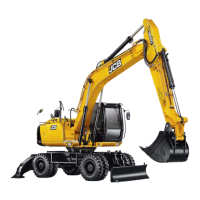Section 1 - General Information
Torque Settings
Hydraulic Connections
1-35 1-35
1-05-01 Issue 02
General
If there is a leak from the hydraulic system:
– Before the hose is disconnected to examine the O-
ring, examine the hose swivel-nut for the broken-line
white marker. If there is no visible white marker,
photograph the hose and adaptor. K
Fig 5. ( T 1-33).
– Open a Tech Web call. Attach the photographs and
make a report of the hose and adaptor part numbers,
and the effected service. Always check the torque of
the hose before its disassembled. If the hose or the
adaptor is loose, you must specify which component
is the cause of the leak.
For example if the hose is tight and the adaptor turns
in the valve block, record this information in the Tech
Web call.
– Examine the O-rings, adaptor thread, hose swaging
and hose damage in the usual method. If the hose
leaks because of chaffing, photograph the chafe point
and attach the photographs to the Tech Web call.
– When a warranty claim is submitted, refer the claim to
the Tech Web call.
– A failure to supply the relevant information could
delay the warranty claim process and possibly cause
the warranty claim to be declined.

